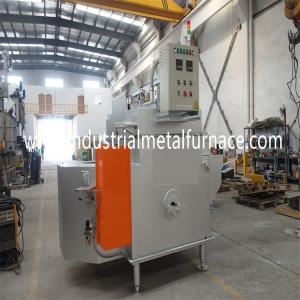
Add to Cart
Pool Type Gas Fired Aluminum Alloy Holding Furnace
1. General Introduction
The gas fired pool type holding furnace is an aluminum alloy liquid holding furnace which could recycle the heat of the fume and saves energy consumption greatly.
The furnace adopts the high quality burner with a large flame radiation size and a high heat efficiency. The aluminum liquid temperature is kept at an accuracy of ±5℃. The furnace inside oxygen content is less than 5% which effective prevents generation of oxides.
The holding furnace for aluminum die casting is designed with the special heat insulation structure which could effectively reduce surface heat loss, reduce environment temperature rise, and improve heat efficiency.
The furnace wall is lined with high alumina refractory bricks which have a service life of more than 3 years.
2. Technical Parameters
The aluminum holding furnace adopts the special burning system and
air fan, which have a low working noise. furnace is used to hold
the aluminum liquid. The furnace has the following parameters.
| Melting pool capacity | 6000Kg (liquid density2.4g/cm3) |
| Fuel type | natural gas heat value |
| Rated working temperature | 850℃ (atmosphere) |
| Temperature rising rate | 60℃/H; |
| Furnace oxygen content | less than 5%; |
| Temperature control accuracy | ±5℃ |
| Energy consumption | less than 7m3/H (continuously working for more than 3 days, and consumption calculated based on 24 hours) |
| Power supply | 380V, 50HZ, 3P 5 wire |
3. Furnace Structure
3.1 Furnace shell
The furnace shell is made of steel plate and sectional steel. The furnace body
can be lifted up so as to work with other equipment.
3.2 Furnace lining
The melting pool is built with high alumina bricks which have the features of
high strength, free aluminum-sticking, and long life. (compression strength:
140Mpa when temperature is above 110℃; linear rate: only 0.1%). The
heat insulation layer used is of Grade One silicate aluminum fiber board.
3.3 Burning system:
The burning system is easy in operation, and has a long service life. The furnace
has the functions of automatic temperature control, automatic ignition, and flame
detection. When the furnace reaches the set temperature, the burner stops working.
When the furnace temperature is lower than the set lower temperature limit, the
burner enters the burner port and works automatically. The burner ignites automatically
with a flame detection device. When the furnace is ready to work, the user
should first turn on the air blower to purge the hearth. The burner ignites automatically
after purging finished and works with a small flame. The flame detection rod
detects the flame, and the burner will work with a big flame. The flame detection rod
monitors the burning status of the burner all the time.
The furnace burning system is also set with safety measures. If there are
situations such as incomplete burning or flame-out, the control system cuts off main
burner and ignition burner to stop the fuel supply. There is also the interlock device
between the gas pipeline and air pipeline. If there is any abnormal burning situation,
the interlock device cuts off the fuel supply. The liquid aluminum temperature is
controlled through PID regulation. The fan inverter automatically adjusts the fan
rotation speed so as to regulate the gas flow. The furnace has set the
atmosphere temperature upper limit value.
3.4 discharging hole
The aluminum liquid is discharged with the help of manual operation. During the
liquid discharging process, there should be no leak problem.
3.5 Temperature control
The holding furnace for aluminum die casting is set with control functions such
as the automatic flame switches, the over temperature alarm, the flame-out
protection, etc.
Aluminum liquid temperature control
Hearth temperature control
Safety device and automatic control system
When the die casting holding furnace is ready to work, the user should first switch
on the power supply and turn on the blower to purge the furnace. Set the furnace
temperature and open the solenoid valve of the gas pipeline. The burner ignites
when the natural gas enters the hearth.